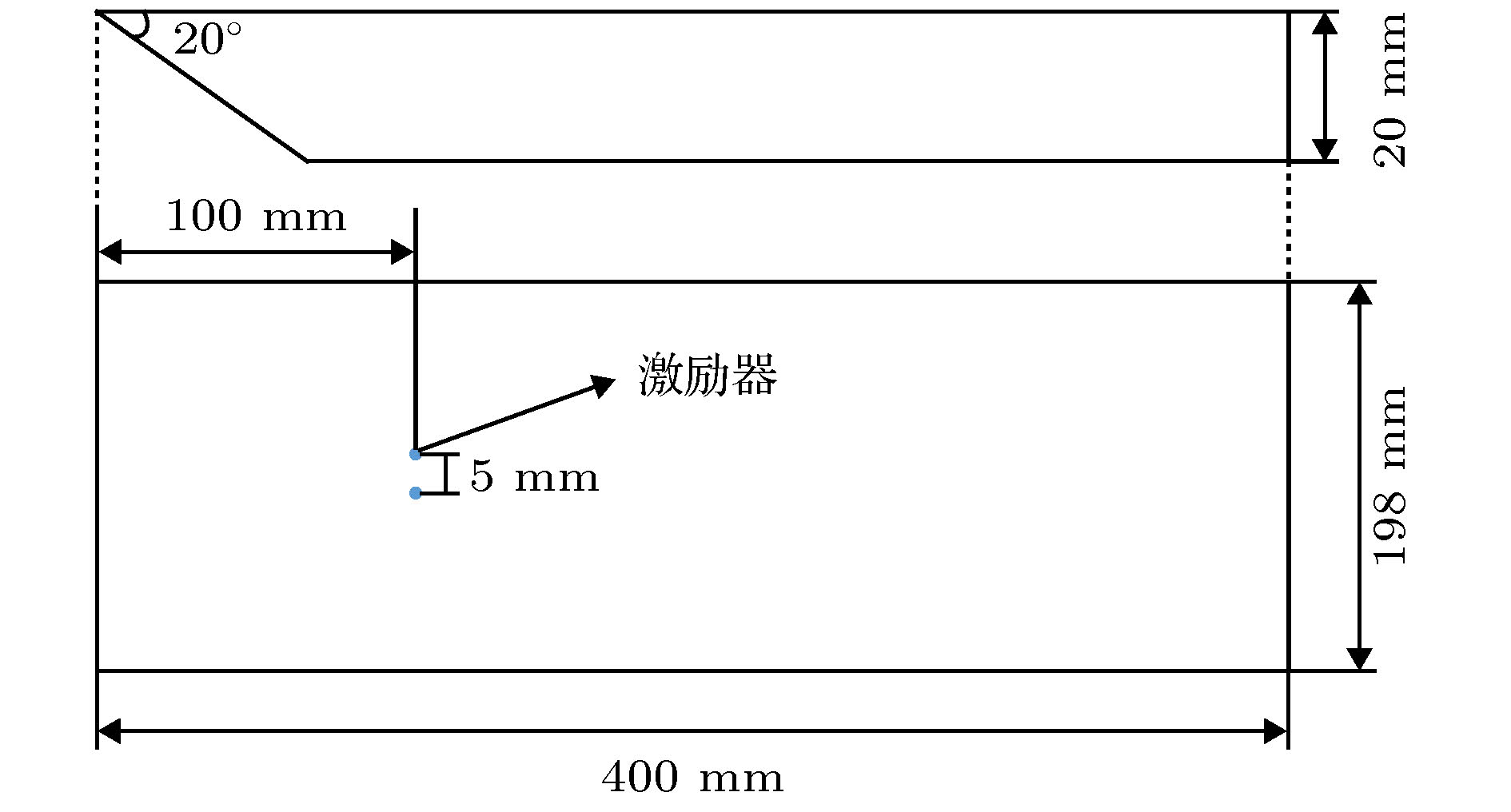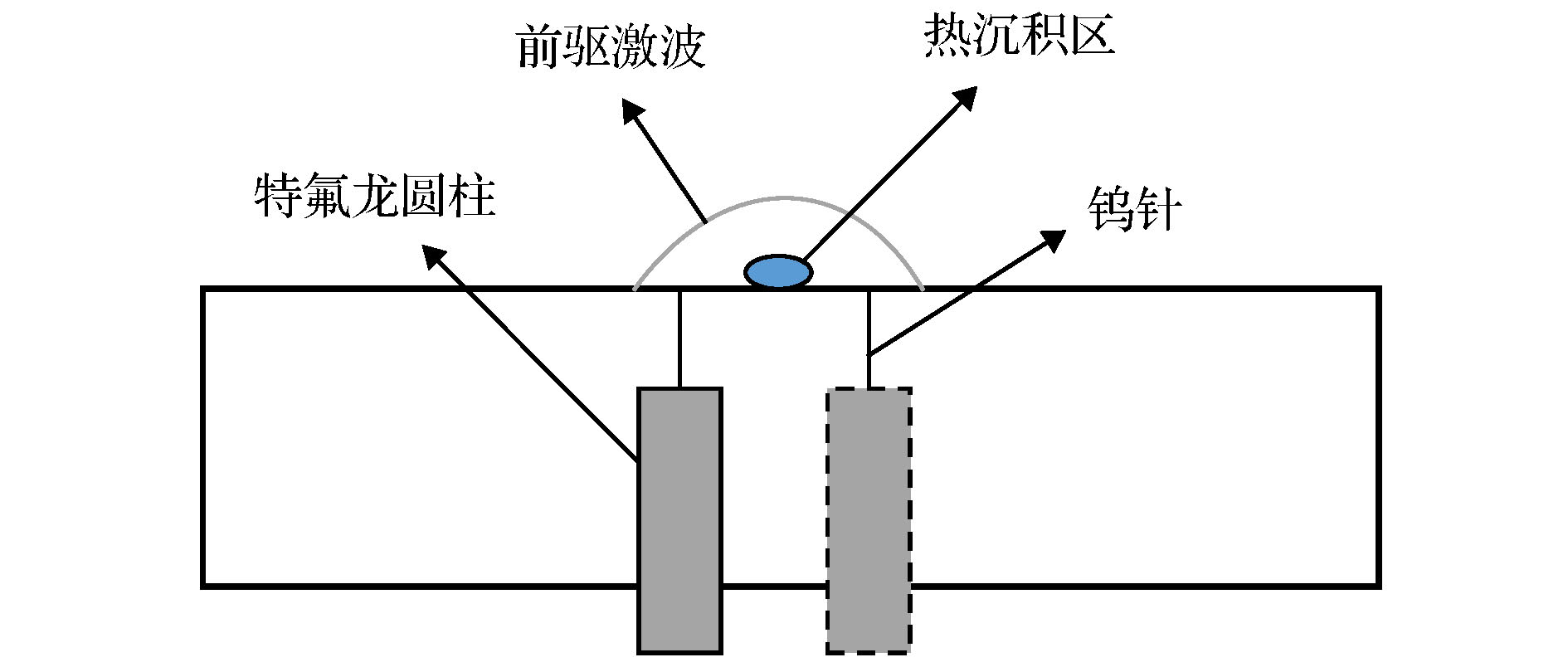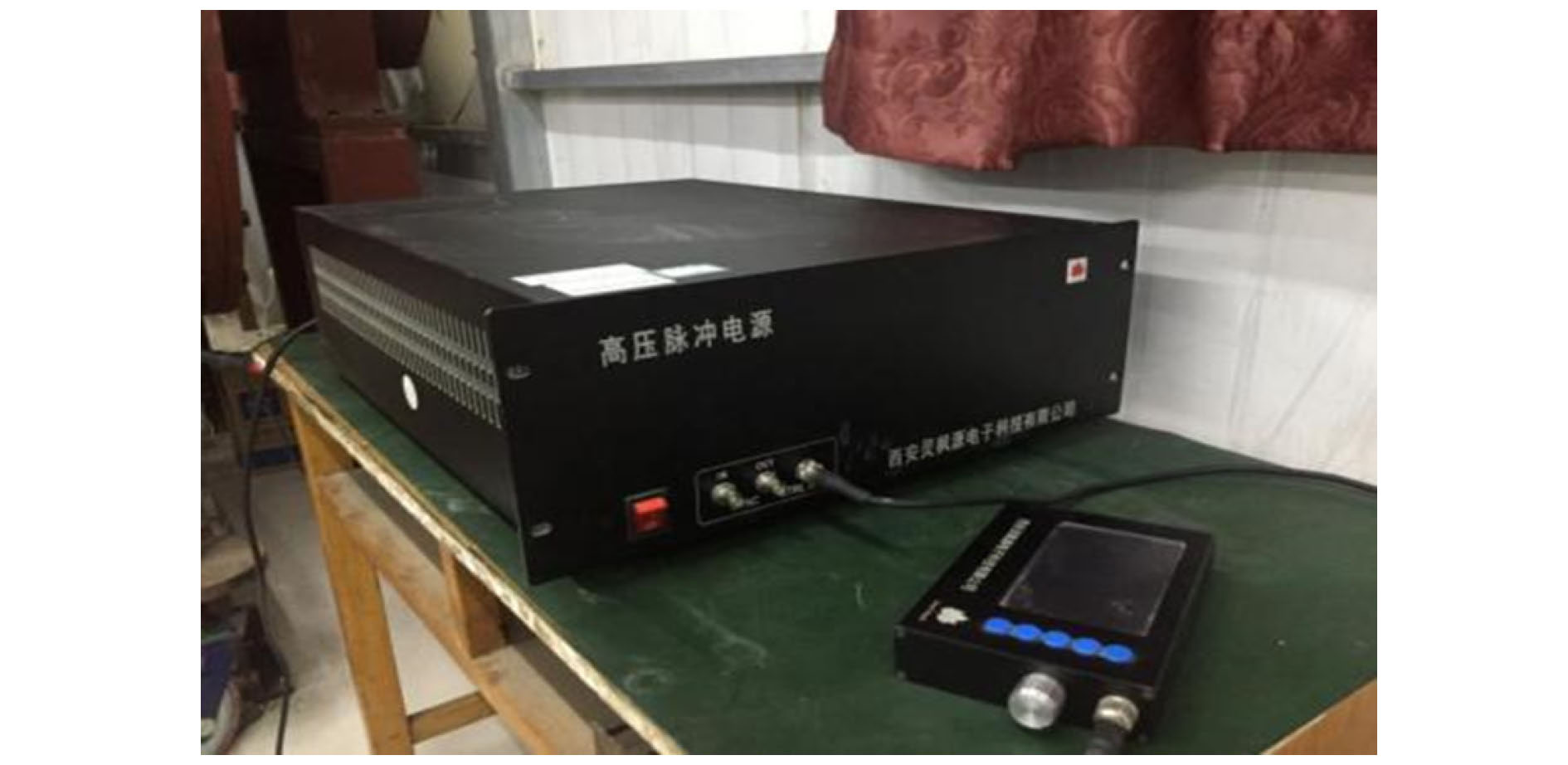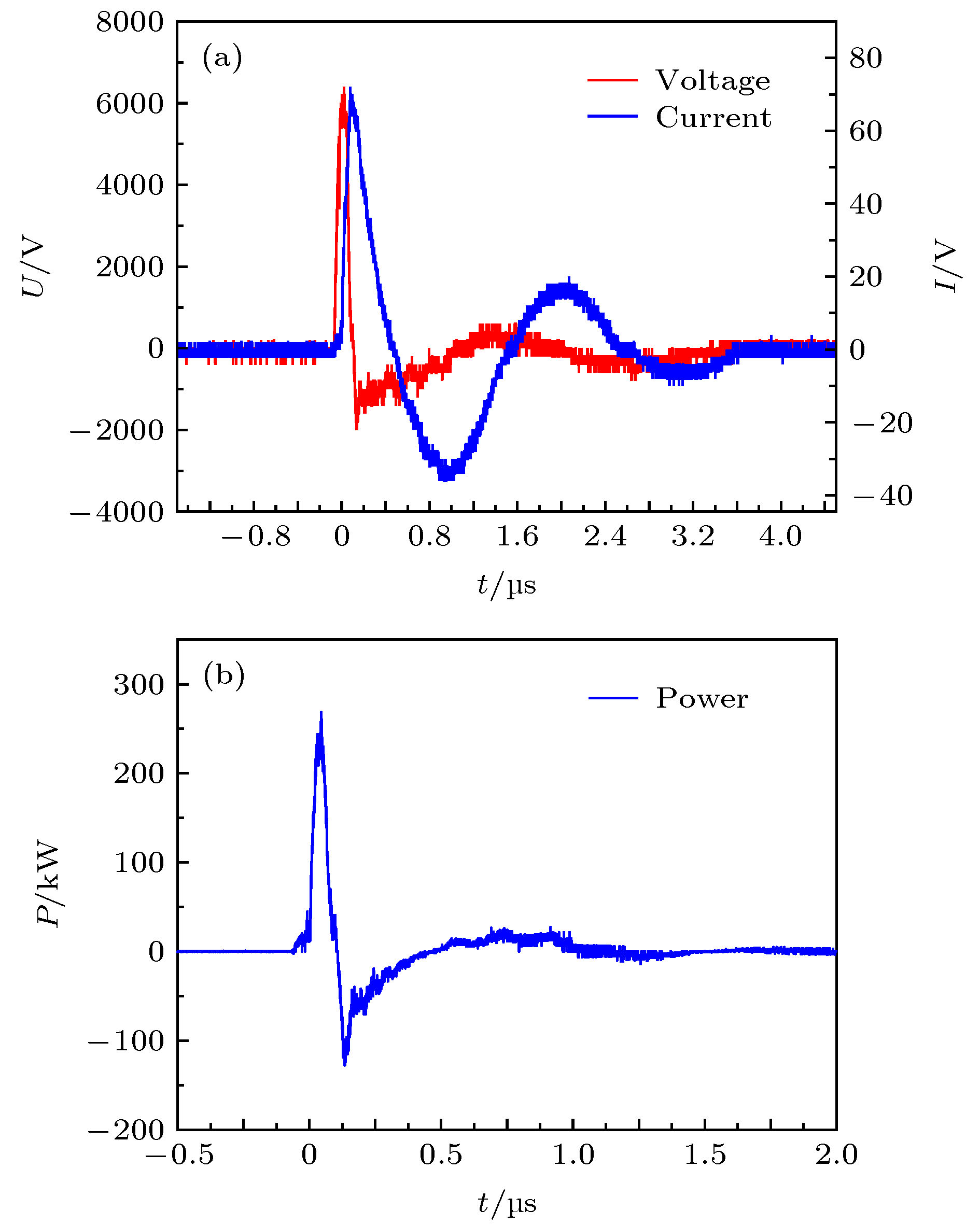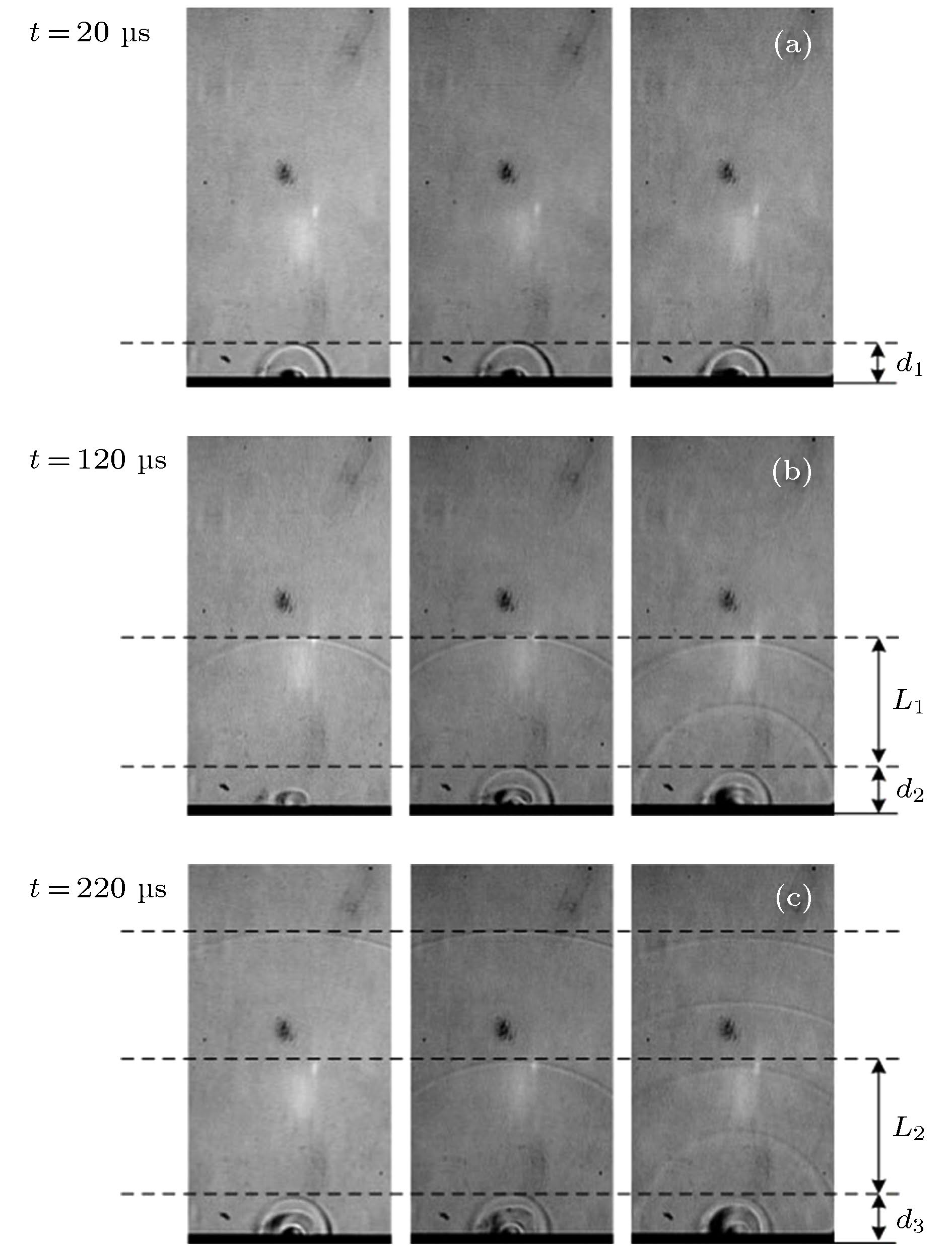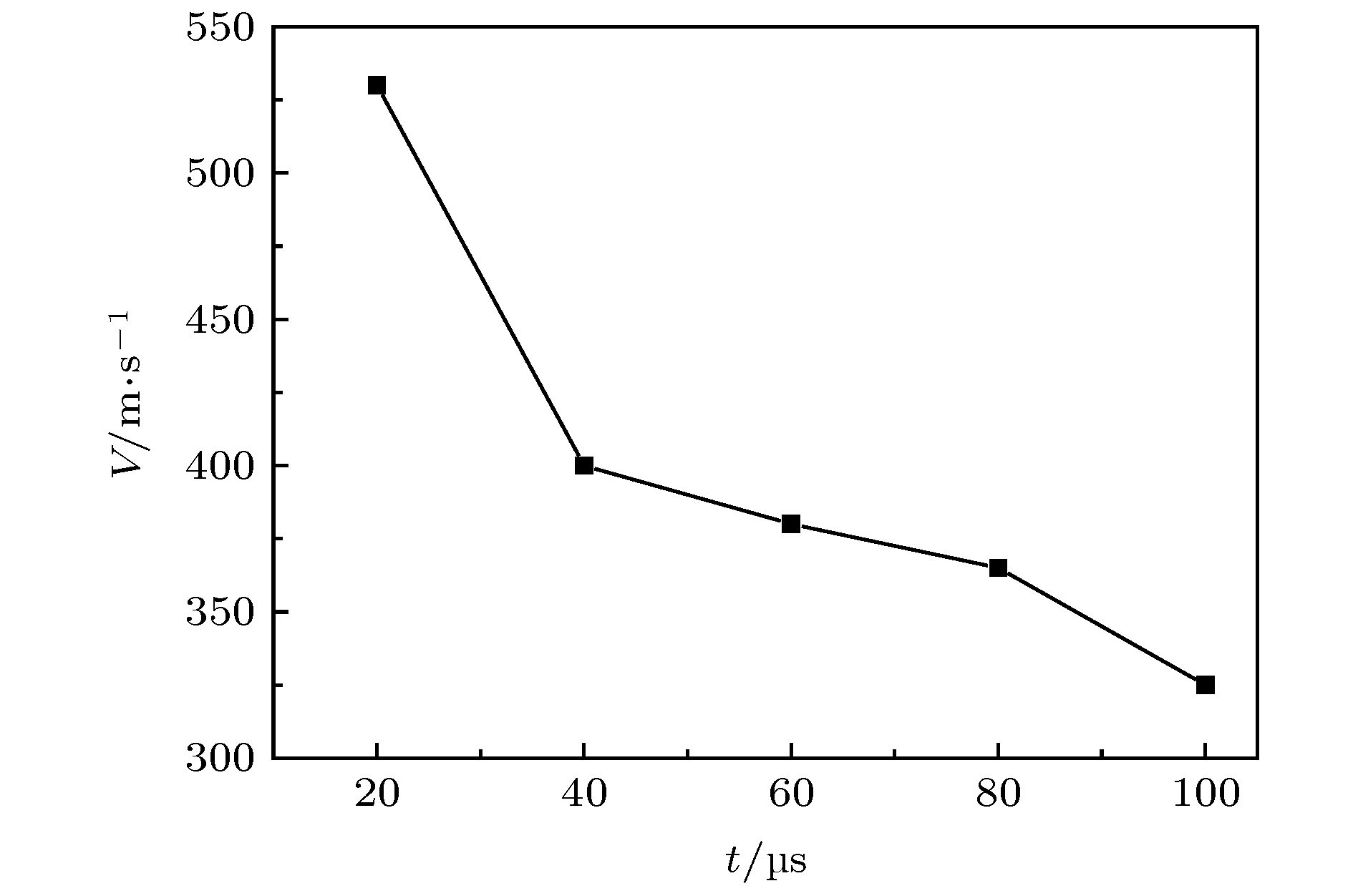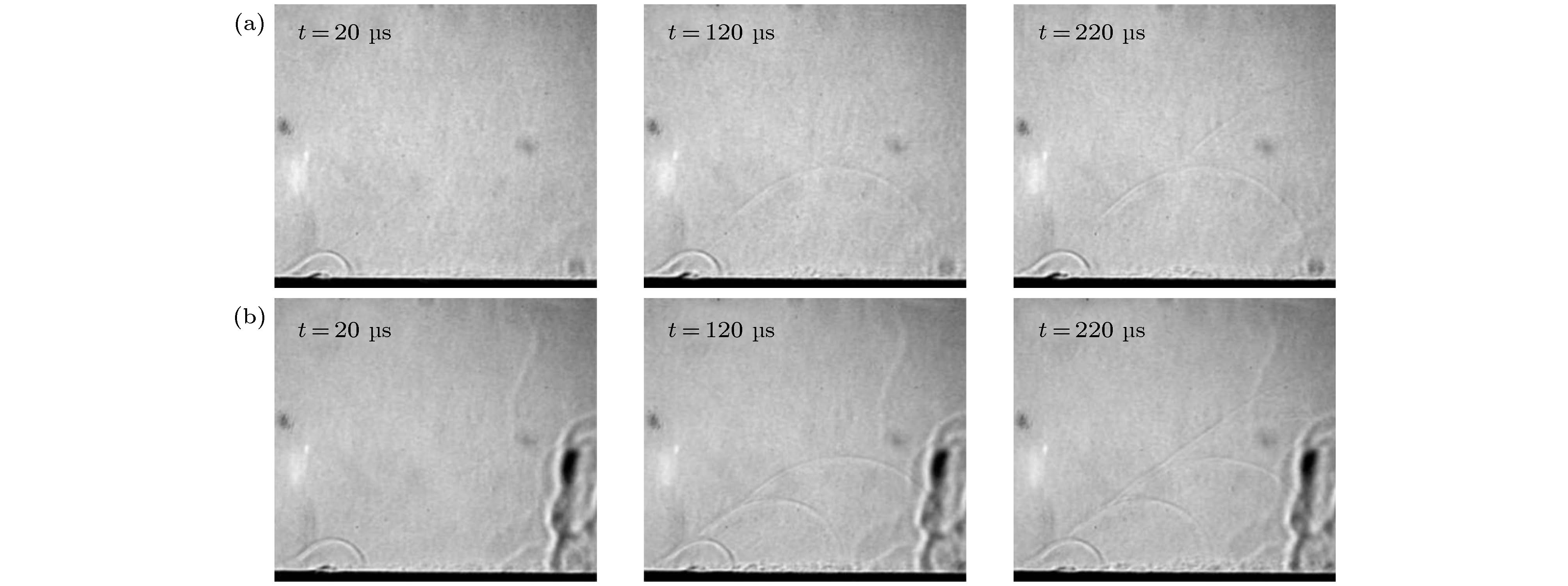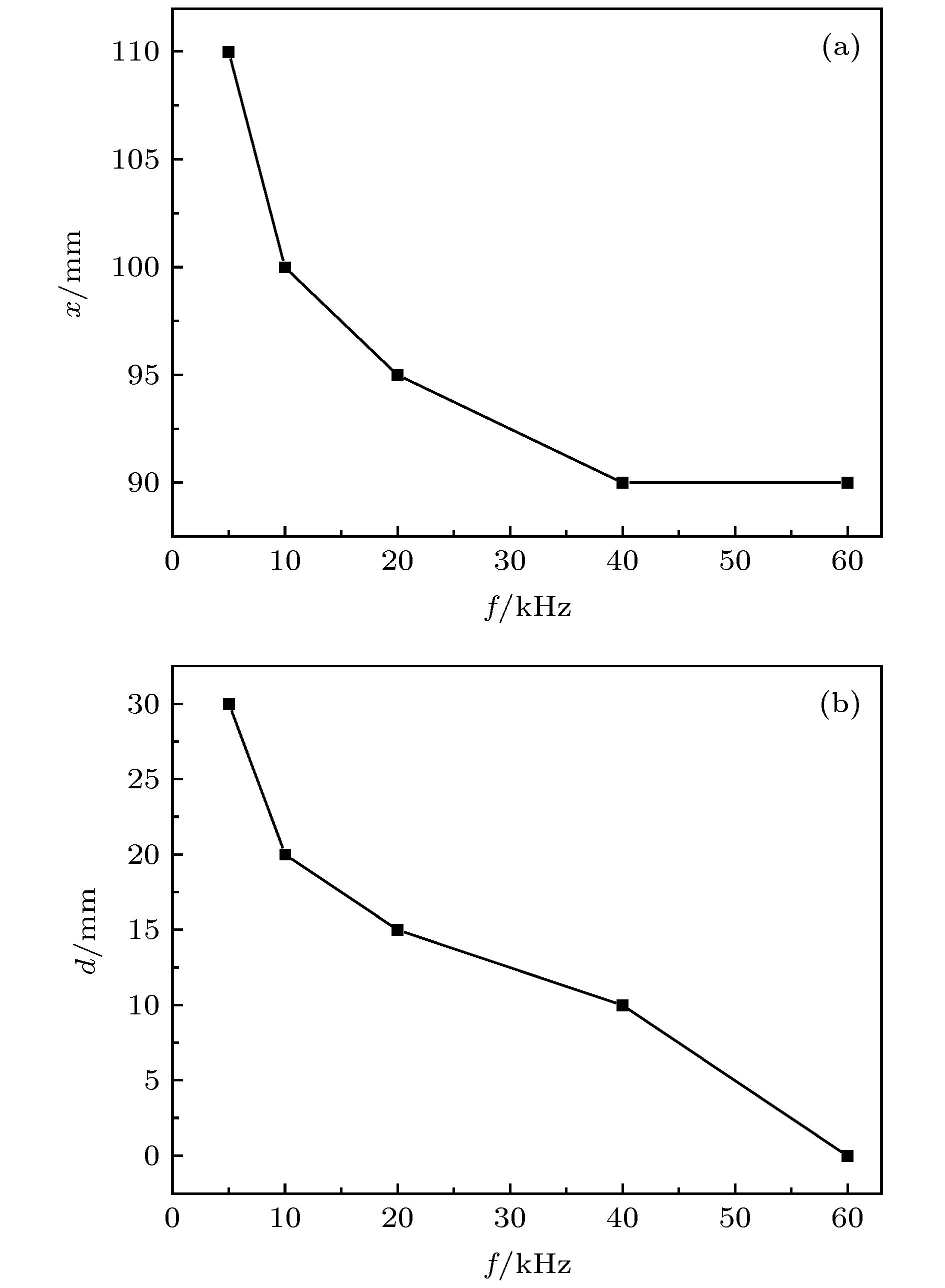-
脉冲电弧等离子体激励器具有局部加热效应强、扰动范围广等特点, 在超声速流动控制中具有广阔的应用前景. 本文运用电参数测量系统和高速纹影技术研究了脉冲电弧等离子体激励器在Ma = 3来流条件下的电特性和流场特性; 采用纳米粒子平面激光散射技术对超声速平板边界层的流动结构进行了精细测量, 并对不同等离子体激励频率下的边界层转捩特性进行了研究. 实验结果表明, 脉冲电弧放电会产生速度较高的前驱冲击波和温度较高的热沉积区, 给边界层施加连续不断的扰动. 施加扰动的脉冲电弧等离子体激励能够促进超声速平板边界层转捩. 并且脉冲放电的高频冲击效应可以促进转捩提前发生, 且频率越高, 效果越好, 当施加激励频率为60 kHz时, 转捩区长度为0, 湍流边界层厚度为25 mm. 脉冲电弧等离子体激励器可以用来促进超声速边界层转捩.
-
关键词:
- 脉冲电弧 /
- 超声速 /
- 转捩 /
- 纳米粒子平面激光散射技术
Pulsed arc plasma excitation is characterized by strong local heating effect and wide disturbance range, and it has a broad application prospect in supersonic flow control. In this paper, by using electrical parameter measurement system and high speed schlieren technique, we study the electrical and flow field characteristics of pulsed arc plasma excitation under the condition of Ma = 3 incoming flow. The nano-particle planar laser scattering (NPLS) is used to investigate the flow structure of the supersonic flat boundary layer, and the transition characteristics of the boundary layer at different plasma excitation frequencies are studied. The experimental results show that in the flow field with Ma = 3 and the total incoming pressure P0 = 1 atm (1 atm = 1.01 × 105 Pa), the peak voltage of the pulsed arc plasma actuator discharge is 6 kV, the peak current is 70 A, the time scale of the discharge is about 300 ns, the single discharge energy is 70 mJ; the pulsed arc discharge will produce the precursor shock wave with higher velocity and the thermal deposition zone with higher temperature, which will exert continuously disturbance on the boundary layer. The pulsed arc plasma excitation with perturbation can promote the transition of supersonic plate boundary layer. Moreover, the high-frequency impact effect of pulsed discharge can promote the transition to occur ahead of time, and the higher the frequency, the better the effect is. As the excitation frequency increases, the transition position of the boundary layer of the supersonic flat plate moves forward, and the length of the transition area of the boundary layer becomes shorter as the excitation frequency increases. When the excitation frequency is 60 kHz, the length of transition zone is 0 and the thickness of turbulent boundary layer is 25 mm. When a high frequency is applied (f = 40, 60 kHz), the transition path of the boundary layer is that the shock wave generated by the plasma excitation triggers the unstable wave, and the development of unstable waves directly skips the linear growth stage, passes through the bypass and transitions into turbulent flow. The pulsed arc plasma excitation can be used to promote supersonic boundary layer transition.-
Keywords:
- pulsed arc /
- supersonic /
- transition /
- nano-particle planar laser scattering
[1] 陈坚强, 涂国华, 张毅锋, 徐国亮, 袁先旭, 陈诚 2017 空气动力学学报 35 311
 Google Scholar
Google Scholar
Chen J Q, Tu G H, Zhang Y F, Xu GL, Yuan X X, Chen C 2017 Acta Aerodyn. Sin. 35 311
 Google Scholar
Google Scholar
[2] Tirtey S C, Chazot O, Walpot L 2011 Exp. Fluids 50 407
 Google Scholar
Google Scholar
[3] 罗金玲, 李超, 徐锦 2015 航空学报 36 39
 Google Scholar
Google Scholar
Luo J L, Li C, Xu J 2015 Acta Aeronaut. Astronaut. Sin. 36 39
 Google Scholar
Google Scholar
[4] 刘向宏, 赖光伟, 吴杰 2018 空气动力学学报 36 196
 Google Scholar
Google Scholar
Liu X H, Lai G W, Wu J 2018 Acta Aerodyn. Sin. 36 196
 Google Scholar
Google Scholar
[5] 杨武兵, 沈清, 朱德华, 禹旻, 刘智勇 2018 空气动力学学报 36 183
 Google Scholar
Google Scholar
Yang W B, Shen Q, Zhu D H, Yu W, Liu Z Y 2018 Acta Aerodyn. Sin. 36 183
 Google Scholar
Google Scholar
[6] 付佳, 易仕和, 王小虎, 张庆虎, 何霖 2015 物理学报 64 014704
 Google Scholar
Google Scholar
Fu J, Yi S H, Wang X H, Zhang Q H, He L 2015 Acta Phys. Sin. 64 014704
 Google Scholar
Google Scholar
[7] Li F, Xie S F, Bi Z X 2014 Mod. Def. Technol. 44 705
 Google Scholar
Google Scholar
[8] 赵慧勇, 周瑜, 倪鸿礼, 刘伟雄 2012 实验流体力学 26 1
 Google Scholar
Google Scholar
Zhao H Y, Zhou Y, Ni H L, Liu W X 2012 J. Exp. Fluid Mech. 26 1
 Google Scholar
Google Scholar
[9] 董昊, 刘是成, 耿玺, 程克明 2018 西北工业大学学报 36 137
 Google Scholar
Google Scholar
Dong H, Liu S C, Geng X, Cheng K M 2018 J. Northwestern Polytech. Univ. 36 137
 Google Scholar
Google Scholar
[10] 黄勇 2011 实验流体力学 20 59
 Google Scholar
Google Scholar
Huang Y 2011 J. Exp. Fluid Mech. 20 59
 Google Scholar
Google Scholar
[11] 王健, 李应红, 程邦勤, 苏长兵, 宋慧敏, 吴云 2009 航空学报 30 1374
 Google Scholar
Google Scholar
Wang J, Li Y H, Chen B Q, Su C B, Song H M, Wu Y 2009 Acta Aeronaut. Astronaut. Sin. 30 1374
 Google Scholar
Google Scholar
[12] 宗豪华, 宋慧敏, 梁华, 贾敏, 李应红 2015 推进技术 36 1474
 Google Scholar
Google Scholar
Zong H H, Song H M, Liang H, Jia M, Li Y H 2015 J. Propuls. Technol. 36 1474
 Google Scholar
Google Scholar
[13] 张攀峰, 刘爱兵, 王晋军 2011 中国科学:技术科学 32 482
 Google Scholar
Google Scholar
Zhang D P, Liu A B, Wang J J 2011 Sci. China-Tech. Sci. 32 482
 Google Scholar
Google Scholar
[14] 陆纪椿, 史志伟, 杜海, 胡亮, 李铮, 宋天威 2016 航空学报 37 1166
 Google Scholar
Google Scholar
Lu J C, Shi Z W, Du H, Hu L, Li Z, Song T W 2016 Acta Aeronaut. Astronaut. Sin. 37 1166
 Google Scholar
Google Scholar
[15] Grundmann S, Tropea C 2007 Exp. Fluids 42 653
 Google Scholar
Google Scholar
[16] Grundmann S, Tropea C 2008 Exp. Fluids 44 795
 Google Scholar
Google Scholar
[17] [18] Sun Q, Li Y H, Cheng B, Cui W, Liu W D, Xiao Q 2014 Phy. Lett. A 378 2672
 Google Scholar
Google Scholar
[19] 甘甜 2018 博士学位论文 (西安: 空军工程大学)
Gan T Ph. D. Dissertation (Xi’an: Air Force Engineering University) (in Chinese)
[20] 唐孟潇 2018 硕士学位论文 (西安: 空军工程大学)
Tang M X 2018 M. S. Thesis (Xian: Air Force Engineering University) (in Chinese)
[21] Leonov S, Bityurin V, Savischenko N 2001 39th Aerospace Sciences Meeting and Exhibit Reno, NV, USA, January 8−11, 2001 p21
[22] Gan T, Wu Y, Sun Z Z, Jin D, Song H M, Jia M 2018 Phys. Fluids 30 055107
 Google Scholar
Google Scholar
[23] Bletzinger P, Ganguly B N, Wie D V 2005 J. Phys. D. Appl. Phys. 38 33
 Google Scholar
Google Scholar
[24] Webb N, Clifford C, Samimy M 2013 Exp. Fluids 54 1545
 Google Scholar
Google Scholar
[25] He L 2011 Ph. D. Dissertation (Changsha: National University of Defense Technology) (in Chinese)
[26] 赵云飞, 刘伟, 冈敦殿, 易仕和, 邓小刚 2015 宇航学报 36 739
 Google Scholar
Google Scholar
Zhao Y F, Liu W, Gang D D, Yi S H, Deng X G 2015 J. Astron. 36 739
 Google Scholar
Google Scholar
[27] Morkovin M V 1968 Mechanics of Boundary Layer Transition, Part 3: Instability and Transition to Turbulence (outline of concepts) (Lecture held at Rhode-Saint-Genese, Belgium)
-
-
[1] 陈坚强, 涂国华, 张毅锋, 徐国亮, 袁先旭, 陈诚 2017 空气动力学学报 35 311
 Google Scholar
Google Scholar
Chen J Q, Tu G H, Zhang Y F, Xu GL, Yuan X X, Chen C 2017 Acta Aerodyn. Sin. 35 311
 Google Scholar
Google Scholar
[2] Tirtey S C, Chazot O, Walpot L 2011 Exp. Fluids 50 407
 Google Scholar
Google Scholar
[3] 罗金玲, 李超, 徐锦 2015 航空学报 36 39
 Google Scholar
Google Scholar
Luo J L, Li C, Xu J 2015 Acta Aeronaut. Astronaut. Sin. 36 39
 Google Scholar
Google Scholar
[4] 刘向宏, 赖光伟, 吴杰 2018 空气动力学学报 36 196
 Google Scholar
Google Scholar
Liu X H, Lai G W, Wu J 2018 Acta Aerodyn. Sin. 36 196
 Google Scholar
Google Scholar
[5] 杨武兵, 沈清, 朱德华, 禹旻, 刘智勇 2018 空气动力学学报 36 183
 Google Scholar
Google Scholar
Yang W B, Shen Q, Zhu D H, Yu W, Liu Z Y 2018 Acta Aerodyn. Sin. 36 183
 Google Scholar
Google Scholar
[6] 付佳, 易仕和, 王小虎, 张庆虎, 何霖 2015 物理学报 64 014704
 Google Scholar
Google Scholar
Fu J, Yi S H, Wang X H, Zhang Q H, He L 2015 Acta Phys. Sin. 64 014704
 Google Scholar
Google Scholar
[7] Li F, Xie S F, Bi Z X 2014 Mod. Def. Technol. 44 705
 Google Scholar
Google Scholar
[8] 赵慧勇, 周瑜, 倪鸿礼, 刘伟雄 2012 实验流体力学 26 1
 Google Scholar
Google Scholar
Zhao H Y, Zhou Y, Ni H L, Liu W X 2012 J. Exp. Fluid Mech. 26 1
 Google Scholar
Google Scholar
[9] 董昊, 刘是成, 耿玺, 程克明 2018 西北工业大学学报 36 137
 Google Scholar
Google Scholar
Dong H, Liu S C, Geng X, Cheng K M 2018 J. Northwestern Polytech. Univ. 36 137
 Google Scholar
Google Scholar
[10] 黄勇 2011 实验流体力学 20 59
 Google Scholar
Google Scholar
Huang Y 2011 J. Exp. Fluid Mech. 20 59
 Google Scholar
Google Scholar
[11] 王健, 李应红, 程邦勤, 苏长兵, 宋慧敏, 吴云 2009 航空学报 30 1374
 Google Scholar
Google Scholar
Wang J, Li Y H, Chen B Q, Su C B, Song H M, Wu Y 2009 Acta Aeronaut. Astronaut. Sin. 30 1374
 Google Scholar
Google Scholar
[12] 宗豪华, 宋慧敏, 梁华, 贾敏, 李应红 2015 推进技术 36 1474
 Google Scholar
Google Scholar
Zong H H, Song H M, Liang H, Jia M, Li Y H 2015 J. Propuls. Technol. 36 1474
 Google Scholar
Google Scholar
[13] 张攀峰, 刘爱兵, 王晋军 2011 中国科学:技术科学 32 482
 Google Scholar
Google Scholar
Zhang D P, Liu A B, Wang J J 2011 Sci. China-Tech. Sci. 32 482
 Google Scholar
Google Scholar
[14] 陆纪椿, 史志伟, 杜海, 胡亮, 李铮, 宋天威 2016 航空学报 37 1166
 Google Scholar
Google Scholar
Lu J C, Shi Z W, Du H, Hu L, Li Z, Song T W 2016 Acta Aeronaut. Astronaut. Sin. 37 1166
 Google Scholar
Google Scholar
[15] Grundmann S, Tropea C 2007 Exp. Fluids 42 653
 Google Scholar
Google Scholar
[16] Grundmann S, Tropea C 2008 Exp. Fluids 44 795
 Google Scholar
Google Scholar
[17] [18] Sun Q, Li Y H, Cheng B, Cui W, Liu W D, Xiao Q 2014 Phy. Lett. A 378 2672
 Google Scholar
Google Scholar
[19] 甘甜 2018 博士学位论文 (西安: 空军工程大学)
Gan T Ph. D. Dissertation (Xi’an: Air Force Engineering University) (in Chinese)
[20] 唐孟潇 2018 硕士学位论文 (西安: 空军工程大学)
Tang M X 2018 M. S. Thesis (Xian: Air Force Engineering University) (in Chinese)
[21] Leonov S, Bityurin V, Savischenko N 2001 39th Aerospace Sciences Meeting and Exhibit Reno, NV, USA, January 8−11, 2001 p21
[22] Gan T, Wu Y, Sun Z Z, Jin D, Song H M, Jia M 2018 Phys. Fluids 30 055107
 Google Scholar
Google Scholar
[23] Bletzinger P, Ganguly B N, Wie D V 2005 J. Phys. D. Appl. Phys. 38 33
 Google Scholar
Google Scholar
[24] Webb N, Clifford C, Samimy M 2013 Exp. Fluids 54 1545
 Google Scholar
Google Scholar
[25] He L 2011 Ph. D. Dissertation (Changsha: National University of Defense Technology) (in Chinese)
[26] 赵云飞, 刘伟, 冈敦殿, 易仕和, 邓小刚 2015 宇航学报 36 739
 Google Scholar
Google Scholar
Zhao Y F, Liu W, Gang D D, Yi S H, Deng X G 2015 J. Astron. 36 739
 Google Scholar
Google Scholar
[27] Morkovin M V 1968 Mechanics of Boundary Layer Transition, Part 3: Instability and Transition to Turbulence (outline of concepts) (Lecture held at Rhode-Saint-Genese, Belgium)
计量
- 文章访问数: 11092
- PDF下载量: 113
- 被引次数: 0














 下载:
下载:
